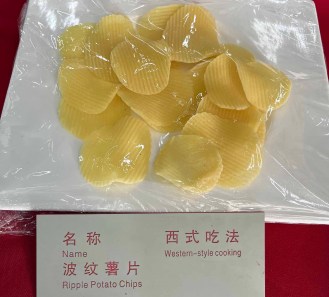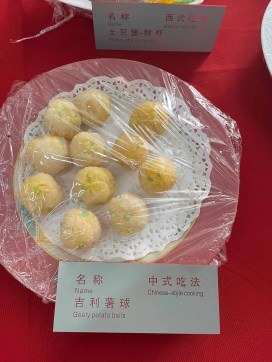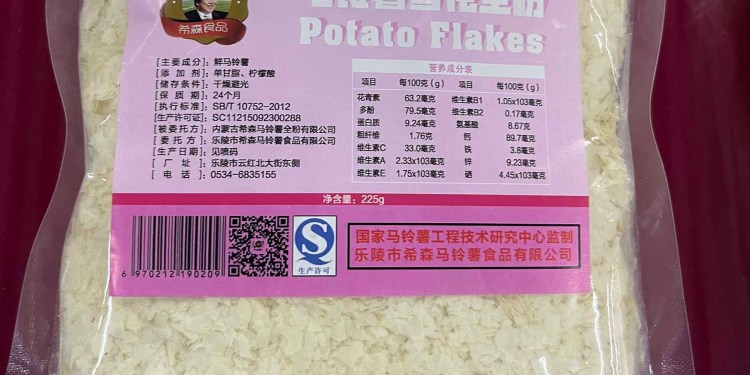The potato food industry in China is developing rapidly. According to various sources, from 10 to 20% of the total crop is sent for processing annually. The main processed products are starch, dehydrated potatoes (potato flakes and flour), chips and frozen french fries.
Starch
The main direction of potato processing is the production of potato starch. The priority of starch is due to two reasons: firstly, it serves as a raw material for further processing, and secondly, the production of starch is the main way to utilize tubers that cannot be sold fresh (small, defective).
Most starch is produced in Gansu and Inner Mongolia. The largest production facilities are located in Gansu (production volume -788,600 tons per year), more than 605,600 tons of starch per year are produced by enterprises in Inner Mongolia.
The largest potato starch manufacturer in China is Inner Mongolia Nailun Agricultural Science and Technology Co., Ltd., with a production capacity of 100,000 tons per year.
There are three potato starch factories in Chongqing, two of them further process the resulting starch into noodles, which solves the problem of labor force caused by the strong seasonality of starch processing.
A number of plants (currently eight) produce both potato starch and modified starch and use wet starch (before drying) to produce modified products, helping to reduce drying costs.
The production capacity of modified potato starch in the country is 458,000 tons per year. With four factories and a total production capacity of 133,000 tons per year, Gansu is the predominant province.
The production of modified starch in China has been carried out since the 1980s, mainly through the physical, chemical, enzymatic or mixed use of various methods to change the properties of natural starch.
According to the China Starch Industry Association, more than 2,000 kinds of modified starch products are currently produced in the country, including oxidized starch, acid modified starch, cationic starch, cyclodextrin, and dialdehyde starch.
In 2019, the total production of modified starch in China was 1,757,800 tons. Varieties of modified starch with a yield of more than 100,000 tons include complex modified starch, oxidized starch, cationic starch, acetate starch, phosphate starch and pregelatinized starch with a yield of 319,200 tons, 279,600 tons, 219,900 tons, 216,100 tons, 155,900 tons and 119,100 tons respectively. The output of these six products is about 75.79% of the total production of modified starch.
The production of modified starch in China is mainly concentrated in the provinces of Shandong, Guangxi, Zhejiang, Guangdong, Jiangsu and Jiangxi, which account for more than 85% of the total output. In 2019, the production of modified starch in Shandong Province amounted to 656.6 thousand tons. There are four enterprises operating in this region with an annual capacity of more than 100,000 tons, accounting for 40.96% of the total modified starch. Among them, the output of Guangxi Nongken Mingyang Biochemical Group Co., Ltd. is 196,000 tons (11.15% of the country’s total production).
The main consumer of modified starch is the Chinese paper industry, which accounts for 58% of the total consumption of modified starch.
Modified starch is also heavily used by the food industry, accounting for 18% of the total consumption of modified starch in China. Starch is used to produce instant noodles, ham sausages, yoghurts and various sauces.
China is a net importer of modified starch, mainly in the form of dextrin and other modified starch. China’s net imports of modified starch totaled 369,100 tons in 2019, up 13.46% from a year earlier, according to the China Starch Industry Association.
The main problems of starch production are related to the fact that this business employs many small enterprises with an annual capacity of less than 10,000 tons, which find it difficult to introduce modern technologies and equipment in a timely manner, to meet the ever-tightening requirements of environmental and tax services. The only way out for them, from the point of view of the government, is to unite and expand the scale of production.
French fries
This potato processing sector is the fastest growing in China.
China’s production of frozen french fries was 63,000 tons in 2006 and rose to 318,000 tons in 2015. The highest average annual growth rate was 64.36% in 2010. In 2016, due to a partial adjustment of wholly foreign-owned enterprises, the scale of French fry production in China decreased slightly. In 2017, the annual production capacity was 281,500 tons with a growth rate of 6.23%.
The main consumers of French fries in China are Western-style fast food restaurants. Experts predict that due to urbanization, the number of such food outlets will increase in the long term, which will also affect the product consumption market. Note that as of February 2020, there were more than 3,500 McDonald’s restaurants and 6,600 KFC restaurants in the country.
Some of the frozen french fries are imported from the US, but the market is showing a downward trend in purchases. So in 2020, imports decreased by 26% at once (the main reason is that all foreign products underwent large-scale long-term testing for Covid-19, restaurateurs were forced to switch to local goods).
French fries production in China in 2022/23 is estimated at 400,000 tons, slightly lower than last year (410,000 tons) due to lower raw material quality. According to industry sources, most processors increased contracted potato acreage in early 2022 to meet increased domestic demand, but this increase was offset by lower quality fresh potatoes.
Between July and September 2023, four new production lines for the production of fries are expected to be commissioned. Their total production capacity will reach an additional 400,000 tons, doubling the available capacity.
Pronounced seasonality can be attributed to the problems of the direction (as well as the entire potato processing industry). Most of the french fry factories are located in the northern monoculture zone, where potatoes are harvested in autumn. Deliveries of potatoes to these productions in the period from April to August are limited, as it is not always possible to keep a sufficient amount of products in the proper quality. Part of the enterprises in the off-season works on imported raw materials.
Chips
The snack industry in China is developing at a very high pace, over the past 10 years, according to the Ministry of Commerce of the PRC, the industry has grown by 422.51%. In many ways, the popularity of products that can be eaten on the go is associated with an acceleration in the pace of life of the population. At the same time, it should be noted that potato chips have to withstand strong competition with other types of snacks that are widespread in the country. In addition, a global challenge for the product is the orientation of consumers towards “healthy snacking” in accordance with global healthy lifestyle trends.

Potato chip factories are mainly concentrated in Fujian province (Dali Garden, Panpan, Qinqin (including Pringles) etc. Shanghai (Lay’s and Oishi) and Beijing (Orion) are also major centers for the production of potato chips, they share accounting for 22.59% and 12.91% of total national sales.
Dali Group is the largest potato chip enterprise in China with annual sales of 16 billion yuan, accounting for 34.42% of the country’s total sales. Dali Group has 18 subsidiaries in 16 provinces and regions across the country. The Copico brand of potato chips is produced at Dali’s 10 subsidiaries located in Quanzhou, Chengdu, Jinan, Hubei, Jilin, Gansu, Maanshan, Shanxi and Yunnan.
Potato flour
Dehydrated potato flour is an important raw material for food production because it is more nutritious than pure starch. Pure starch-based noodles (and similar products) can only provide glucose to the human body, while whole potato products, such as mashed potatoes made from dehydrated potato flour, retain the nutritional value of the whole potato tuber, i.e. starch, protein, vitamins, dietary fiber and minerals [Camire et al. 2009]. The industrial production of dehydrated potato flour is very important for the development of ready-to-eat healthy and nutritious mashed potato products suitable for the Chinese population [Mu et al. 2017].
Other processed potato products
In recent years, China has increasingly introduced changes in the recipes of traditional products that were previously made on the basis of wheat or rice flour. When preparing steamed bread, flatbread, wheat and rice noodles, dumplings, potato flour is added to the usual set of ingredients. The main goal of innovations is to improve the quality and diversity of nutrition of citizens of the country.
Studies show that bread made from dough with the addition of potato flour has improved nutritional and functional properties.
physical qualities [Blades et al. 2008]. Adding potato flour to wheat flour has been reported to help reduce gluten levels and prevent complications associated with celiac disease [Ijah et al. 2015]. At the same time, the specialists developing the recipe make every effort to ensure that the updated product retains its familiar look and taste. Thus, it has been noted that too high a proportion of potato granules can impair the rheological properties of the dough [Xu et al. 2017]. For making bread, it is recommended to use flour from certain varieties of potatoes (Hunmei, Blue Congo, Shepodi and Atlantic).
At present, more than 200 types of potato staple foods have been developed in China, and some of them have been successfully commercialized.

The mass production of a number of new products is hampered by the lack of special technologies and equipment, but this problem is being gradually solved. An example is the potato starch noodle industrial production line developed by Chinese scientists and engineers. Products come off the assembly line that, on the one hand, fully correspond to the traditions of Chinese culture, and, on the other hand, are a product of the modern potato processing industry [Chen et al. 2017]. From a technological point of view, the noodle production line is comparable to the production lines for french fries, dehydrated potatoes, starch, etc.
In Southwest China (provinces such as Chongqing, Sichuan, and Guizhou), there is a traditional ready-to-cook potato that is worth industrial production. The potatoes are steamed, then cut into thick slices and dehydrated. The result is a clear, chewy product similar to dehydrated abalone, commonly referred to as “vegetable abalone”. This kind of semi-finished potato not only solves the problem of storing potatoes, but also, based on the eating habits of the population of southwestern China, can be used to prepare a very tasty dish. There is a need to develop specialized drying equipment for processing this type of high-quality semi-finished potato products in order to reduce the time of dehydration – “sun drying”.
Based on Potato Processing Industry in China: Current Scenario, Future Trends and Global Impact; Zhao-jun Wang, Hong Liu, Fan-kui Zeng, Yan-chen Yang, Dan Xu, Yu-Ci Zhao, Xiao-feng Liu, Lovedeep Kaur, Gang Liu & Jaspreet Singh.

